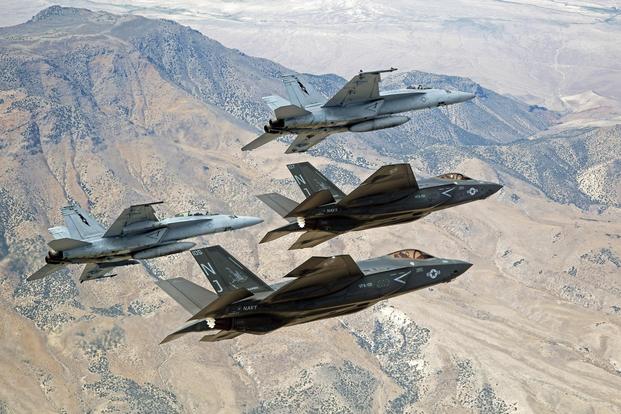As the U.S. Navy expands its aircraft fleet with the fourth-generation F/A-18E/F Block III Super Hornet and fifth-gen F-35 Joint Strike Fighters, a challenge remains: How will the jets connect and share information without sacrificing stealth?
Boeing Co. on Wednesday showcased its Block III Super Hornet, which comes with a larger variety of weapons, extended range, advanced targeting and sensor systems, and better fuel efficiency, among other enhancements. The company noted the Block III isn't meant to be a direct competitor to the F-35 Lightning II; it's meant to be its partner.
The Super Hornet and F-35 “are the Navy's two frontline fighters, and will be for decades to come," said Dan Gillian, manager of F/A-18 and EA-18 programs at Boeing.
Yet the two aircraft currently don't have a way to communicate without compromising the F-35's stealth.
Related content:
- Upgraded Super Hornet Features Only Minor Stealth Improvements
- Advanced Data Sharing, Range Expansion on Eglin Test Wing's Agenda
- New Pilot on Navigating F-35 Comms: 'It Is Extremely Simple'
"For sure, that is part of the roadmap, and how do we get that right?" said Capt. David Kindley, F/A-18 and EA-18G program manager. Kindley briefed reporters at Boeing's facilities in Arlington, Virginia, on Wednesday, alongside officials who lead the program.
"It's fairly a statement of the obvious: F-35's challenge is they need to stay sneaky, and they need to transmit. Those can be [incompatible] to each other. So how do we solve that? So we're trying to offer as many options as we can to plug into, and we're talking about this going forward," he said.
Even if the F/A-18 -- now undergoing modifications to give it upgraded stealth capabilities -- is a little less detectable from enemy radar, the F-35 would likely lead the charge in a heavy surface-to-air missile environment.
"We're not going to send Super Hornets into the heart of an IADS [Integrated Air Defense System]," Kindley said. "But that's always a trade-off we're going to have to work on."
Fifth-generation platforms like the F-35 use the Link 16 datalink to transfer information to fourth-gen counterparts. But the F-35 also internally operates on its Multifunction Advanced Data Link system, known as MADL.
"There's a whole discussion ongoing within [the Defense Department] on how you link F-35s, all aircraft together," said Bob Kornegay, senior manager of business development for the F/A-18E/F and EA-18G at Boeing.
Interoperability is at the heart of how a strike wing will operate in the future, Kindley added.
Boeing will deliver its first test Block III jets to the Navy in 2019, with a production line starting sometime in 2020, Gillian said.
The Navy intends to have Boeing convert more than 500 of its Block II jets and produce 116 new Block IIIs by 2024. The new jets' first deployment is expected sometime in 2022.
When asked whether President Donald Trump's involvement has given the defense firm confidence, Boeing officials said Block III has been in discussion "for some time."
"The president's engagement has certainly brought energy and drive to [this] discussion," Gillian said.
Trump in recent months has repeatedly cited a desire to see Boeing build a stealthy F/A-18 Super Hornet and potentially scale back F-35 production from competitor Lockheed Martin Corp.
"It's the collection of things together: next-generation fighter, we've delivered 100 percent of our airplanes on time, on cost, and that resonates with this administration," Gillian said.
-- Oriana Pawlyk can be reached at oriana.pawlyk@military.com. Follow her on Twitter at @Oriana0214.










